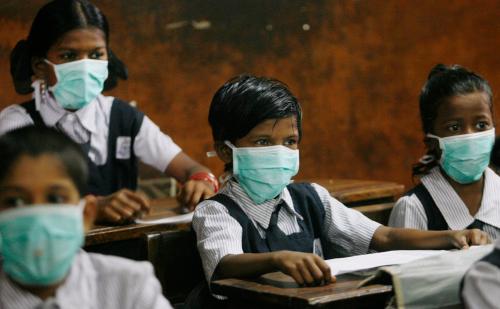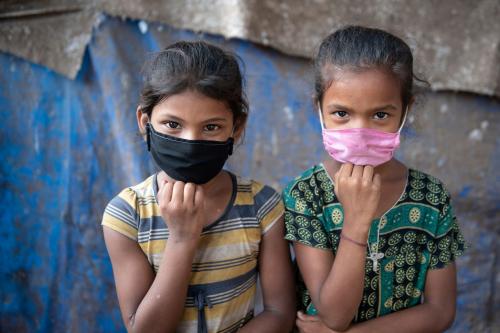After several years of mostly virtual convenings and events, 2023 brought us back to in-person events around the world and allowed us to learn and share with each other. We are pleased to have had so many opportunities to gather and meet with colleagues from all corners of the world to share our research on the overall global impact bonds market as well as cost analysis and real-time data collection in education, both critical elements of impact bonds. From our conversations, it is clear that the ongoing challenges that the world faces, including conflict on multiple continents, climate catastrophe, and the worldwide learning crisis, require unwavering attention and support. Each day the news reminds us of the essential role our research and work play in helping to tackle these global issues.
Impact bonds market
The impact bonds market continues to grow, with 253 total projects from around the world captured in the Brookings Global Impact Bonds database. This growth largely took place in the social welfare, health, and education sectors and was bolstered by the official launch of the Ghana Education Outcomes Program (GEOP) at the beginning of the year. The GEOP is a social impact bond funded by both the government of Ghana and the Global Partnership for Results-Based Approach (GPRBA) at the World Bank through a grant provided by the United Kingdom’s Foreign, Commonwealth and Development Office, with the dual goals of improving primary-school learning outcomes and reintegrating out-of-school children back into formal primary schools. The program aims, over 48 months, to reach over 175,000 children ages 8-18, including 70,000 who are out of school, and features an exceptionally strong emphasis on equity through an outcome payment premium for girls’ learning.
With the launch of the GEOP, as well as sister project Sierra Leone Education Innovation Challenge (launched in September 2022), educational outcomes for over 300,000 children in West Africa have the potential to be improved through social impact bonds. Indeed, these two programs are indicative of a trend of larger impact bond projects, with beneficiary numbers in the thousands and even tens and hundreds of thousands, in low- and middle-income countries (LMICs). Our research shows that the average number of targeted beneficiaries in a project in a LMIC is nearly 77,000, while that same number for high-income countries is just over 5,000.
2023 also saw the completion of quite a few projects across the globe, largely in high-income countries. Highlighting the difference in average project size between LMICs and high-income countries, the two projects that closed in Denmark this year were highly bespoke: one aimed to reduce stress levels in 84 participants so they can return to the employment market and another focused on unemployed people diagnosed with autism with a target of just 10 beneficiaries. It is important to consider that while some projects may have a smaller number of total beneficiaries, a focus on the most marginalized may still have a large impact. We look forward to continuing to track the market to see if these differences continue to hold out or if new trends in the market emerge.
Childhood Cost Data initiative
This year, our long-running work in costing culminated in the June launch of the Childhood Cost Calculator (C3). C3 is an online, free-to-use tool for completing cost analysis exercises (costing) through a user-friendly, survey-based application. The development of C3 was sparked by our research on outcome-based financing (OBF), specifically the four types of data necessary for the successful design and implementation of OBF projects, which includes accurate, high-quality cost data. It replaces the Standardized Early Childhood Development Costing Tool launched by the Center for Universal Education in 2017, expanding far beyond the original vision of the costing tool. The tool has been augmented to be applicable to interventions in a wide range of sectors related to children and youth including education (early childhood through tertiary), health, nutrition, water and sanitation, social protection, and governance. C3 can be used by multiple stakeholders, including policymakers, funders, and researchers, to answer the costing questions below:
Questions for Planning
- What resources are needed to deliver an intervention?
- Is the project feasible within a given budget?
- How do the costs of intervention A compare to those of intervention B?
- What are the cost drivers of this intervention?
- What is the cost per beneficiary (unit cost) of an intervention or program?
Questions for Adaptation and Changes
- What are the cost implications of a programmatic change, such as in dosage?
- What would be the cost of scaling up a program or intervention?
Questions about Cost Distribution
- How are the costs distributed across cost categories for this intervention or program?
- How are the costs distributed across resource types for this intervention or program?
- How are the costs distributed between investment costs and recurring costs?
C3 was piloted in three countries with interventions in early childhood (Cambodia) and general education (Ghana and Honduras) alongside teams that were highly motivated to complete a costing exercise to support their own projects. It was developed as a straightforward and simple-to-use tool with the intention of localizing costing efforts by reducing reliance on outside economists and specialists. Piloting showed that the teams were able to undertake the costing process themselves, with intermittent check-ins with the Brookings team. The piloting process also allowed us to see the tool at work and make real-time improvements before a global launch. In September we released a final report on the piloting of C3, co-authored with our partners, that spotlighted both the outcomes of the cost analysis as well as the experience of each team.
High-level aggregated data for each of the three costing exercises is included in the Cost Data Explorer, located on the Childhood Cost Data initiative website. As more costing exercises are completed using the tool, the Explorer will expand, building a searchable database of global cost data related to child- and youth-centered interventions.
The launch of C3 represents a significant milestone in our costing work, but is not the end of the road. Looking forward, we envisage releasing C3 in multiple languages to further our efforts to localize costing work and hope to eventually expand the tool’s capabilities to encompass cost-benefit analysis.
Real-time data for outcomes
Last year we launched the Digital tools for real-time data collection in education report, focusing on the critical need for real-time data to track activities and progress in education. Along with the report, we released an accompanying interactive database of existing digital tools already being used in LMICs around the globe. This year saw 10 new tools added to the database, and we continue to crowdsource for new additions that should be included. If there is a digital tool for data collection in education that you have developed, are using, or know about, please reach out to us at [email protected].
What’s next?
There is much to look forward to in the upcoming year, including the Outcomes Finance Alliance (formerly the Impact Bonds Working Group) Summit in early March. We are excited to learn more about the progress of the first Outcomes Accelerator cohort, which includes a proposal from maze impact and partners for the design of an impact bond targeting 30,000 pregnant women and their families in Angola, as well as two other outcome-based financing projects. Additionally, we hope to hear about the second cohort which will feature projects focusing on Sustainable Development Goals 8 (Decent Work and Economic Growth) and 13 (Climate Action). The first call for proposals yielded 84 expressions of interest, emphasizing the sustained enthusiasm for using outcomes-based financing mechanisms for meeting the SDGs.
We also look forward to continuing to participate in a number of steering and advisory groups focusing on innovative finance, including the Education Finance Network, which brings together education stakeholders to increase nonstate resources to improve educational outcomes and equity. These opportunities are a testament to the enduring interest in innovative finance to confront some of the world’s greatest challenges.
Costing will continue to be an important focus for our team in the new year. We are starting the year with a costing workshop in early January, bringing together funders and researchers to coalesce around a global agenda for costing in education. In February, we will join nonstate education providers and other education stakeholders in Accra, Ghana for the Global Schools Forum Annual Meeting and in March we will present our work on the 4 types of data necessary for outcomes-based financing and the C3 at the Comparative and International Education Society (CIES) 2024 Conference.
As we reflect on the many things we have learned from colleagues in both formal and informal settings this year, and how much we have to look forward to in 2024, we welcome you to share your thoughts about and work in these spaces with us.








Commentary
A review of outcomes-based financing in 2023
A year of global challenge and growth
January 5, 2024